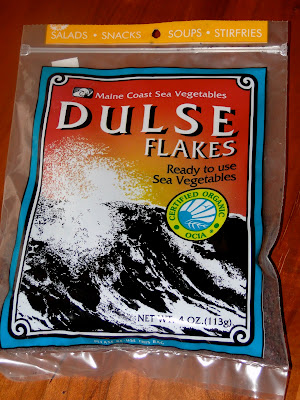Yesterday I revealed the results of my investigation into imitation crab, which shows up in sushi rolls and salads every now and then. Turns out it’s not really a “whole food,” considering it contains artificial colors and flavors and is highly processed. But the good news is that other types of sushi can be healthy, and it’s even better when you pair it with a fresh seaweed salad.
Seaweed salad usually contains a few different types of seaweeds, such as nori, kelp, hijiki, kombu, wakame, arame, or dulse. Seaweeds can grow in salt water or fresh water lakes, and Japan is currently the largest producer and exporter of sea vegetables. They have been enjoying them for over 10,00 years, and many of our recipes using seaweeds are inspired by Japanese cuisine. Seaweeds are becoming more popular and can now be found in most health food stores and even some regular grocery stores, rather than just at Asian food markets.
Seaweed is known for its strong nutritional profile. They contain very few calories – less than 20-30 calories per half cup serving. They are rich in iodine, with one serving containing up to 300% of our recommended daily intake of iodine. Fish is another great whole food source of iodine, but other than that it can be difficult to obtain from a whole foods diet. Table salt is iodized, but it is also highly processed and since the iodine is added in, it may not be as bioavailable to our bodies. Sea vegetables are also rich in potassium, magnesium, phosphorous, calcium, iron, tryptophan, folate and other B-vitamins, vitamin A and vitamin K.
Those who consume kelp and other sea vegetables on a regular basis as part of a whole foods diet will experience amazing health benefits and transformations. The phytonutrients in seaweeds work to inhibit the growth of cancers. Iodine found in seaweeds is vital for proper thyroid function, because iodine is a component of thyroid hormone that is essential for regulating metabolism and many other functions inside our cells. The anti-inflammatory potential of seaweeds comes from its magnesium content, which helps with things like migraine headaches and asthma. Seaweeds can also cause relief for women going through menopause by easing symptoms.
Seaweed salad is available at most sushi restaurants, but that doesn’t have to be your only source. Since seaweeds are so available to us now, I recommend keeping some in your cupboard and using it for things like salads, soups and on top of some chicken or cooked veggies. Right now I have Pacific arame and dulse flakes in my kitchen. The arame is really great for salads or soups (pictured below). It needs to be soaked in cold water for about 15 minutes and then is ready to be eaten. The texture is a little slimy (for lack of a better word), kind of what you'd expect for seaweed texture.


The dulse flakes are great for sprinkling on just about anything that would taste good with a saltier flavor. I love the flakes because they are so easy to use – no soaking or cooking necessary (pictured below).


If you are looking for some variety in your diet and a great whole food source of iodine and other minerals, I recommend picking up some seaweed/sea vegetables at a health food store. Kelp can be harder to find but is available to order online from certain companies that harvest and dry the kelp (British Columbia Kelp is one good company I know of). Don’t be afraid to try new things with the seaweeds, and next time you’re out for sushi, be sure to order the seaweed salad!






Are there any seaweeds that should be avoided for any reason, or any that are more nutritious than others? I assume it's best to buy organic.
ReplyDeleteYipes, I wouldn't recommend those seaweed salads in restaurants! They're full full full of SODIUM & SUGAR... pretty much negating the health benefits of seaweed!
ReplyDeletePeople should simply buy the packages you posted here... as well as nori sheets! I make my OWN sushi rolls without rice, just nori sheets & veggies, super delish!